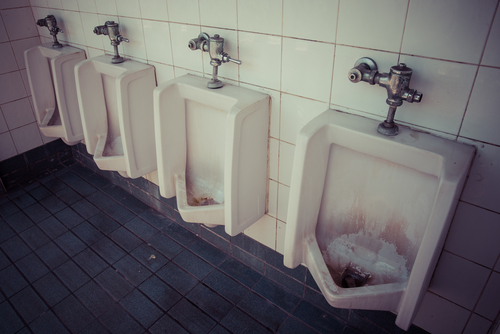Only 1 in 5 public restrooms meet hygiene and cleanliness expectations, and negative experiences are impacting business revenue and reputation, according to a new survey.
Tork, an Essity brand, announced findings of a global survey of restroom users and cleaning staff that explores attitudes toward hygiene in public restrooms, the hygiene barriers that users encounter, the challenges cleaners face, and the consequences of a poor restroom experience.

Expectations & Experiences
The research, which surveyed 11,500 people across 11 countries, shows there are high expectations for public restrooms, with 74% of respondents expecting moderate or high levels of hygiene. Yet, only 20% of restrooms deliver on those expectations. Forty percent of the general population is “very concerned” with hygiene and cleanliness of public spaces, and that number jumps to 60% for people with conditions like germaphobia.
A poor restroom experience can trigger powerful emotions and measurable business consequences. When expectations for cleanliness are not met, users feel disgusted (27%), uncomfortable (26%), and frustrated (22%). And 52% of people take action after a poor restroom experience, including:
- 28% have spent less time at a venue because of the state of the restroom;
- 23% have limited how much they eat or drink, in order to avoid needing the restroom—showing a direct impact on business revenue;
- 11% have told their friends to avoid the location, and 7% have left a poor online review; and
- 1 in 4 people spent less time at their workplace due to poor restrooms, and 15% worked from home more than they otherwise would—affecting employee satisfaction and productivity.
Additionally, in the U.S., younger generations are holding venues to higher standards: 21% of 18- to 34-year-olds said they would not return to a venue because of the restrooms, compared to 14% of the general population and 16% of 35- to 44-year-olds. That number goes down as people get older:
- 12% of 45- to 54-year-olds said they wouldn’t return to a venue because of the restroom;
- 10% of 55- to 65-year-olds said they wouldn’t return; and
- 8% – 9% of 66- to 70-plus-year-olds said they wouldn’t return.
Although public facilities provide accommodations for some prevalent physical circumstances and conditions, such as people who use wheelchairs, the research also reveals that many needs remain unrecognized in restroom maintenance and design.
Across the 11 countries surveyed, 54% of venue visitors contend with some form of physical or cognitive challenge that can impact their public restroom experience. That number increases to 59% in Canada and 60% in the U.S.
Physical conditions include:
- Skin sensitivities
- Incontinence
- Chronic pain
- Mobility issues
Cognitive conditions include:
- General anxiety
- Discomfort in shared/crowded spaces
- Visual and/or hearing impairment
- Neurodivergence
Where Public Restrooms Fall Short
Survey respondents across countries cite that they avoid restrooms because they are “unhygienic” (No. 1 reason), have unpleasant smells or odors (No. 2 reason), soap and toilet paper are unavailable (No. 3 reason), or the restroom provides insufficient privacy (No. 4 reason).
The survey also asked respondents to identify the types of public locations that most often fail to meet their restroom expectations. Respondents in the United States identified the following venues:
- Convenience stores: 30% say these rarely or never meet expectations
- Train and bus stations: 25%
- Shopping malls: 25%
- Sports stadiums and arenas: 24%
- Fast food restaurants: 19%
“These findings reinforce the need for more consistent inclusive hygiene standards across high-traffic public venues,” said Katrin Ferge, regional segment manager of commercial and public interest at Essity. “When restrooms fall short, it not only affects individual comfort and dignity—it can also lead to lost business, negative word of mouth, and reduced employee satisfaction in the case of a workplace.”
The Reality of Cleaner Burnout
The research also explored the challenges that cleaners face when working within the restroom setting, including:
- 80% reported mental health issues as a result of their jobs; 46% of those individuals say they feel stressed;
- 70% cite inadequate employer support; and
- 38% have left a cleaning job as a result of not feeling recognized or due to burnout (unrelated to pay/compensation).
Reduced employee well-being and employee turnover can directly impact facility cleanliness, the restroom user experience, and result in costly hiring and onboarding. According to Tork, meeting the needs of cleaning staff—for example, providing easy-to-refill, high-capacity dispensers—can support inclusive hygiene and boost the bottom line of businesses.
